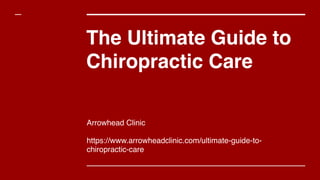Ultimate guide to chiropractic care
- 1. The Ultimate Guide to Chiropractic Care Arrowhead Clinic https://www.arrowheadclinic.com/ultimate-guide-to- chiropractic-care
- 2. What is a Chiropractor? Dating back to the late 1800s, Daniel David Palmer developed the term "Chiropractic" by combining the Greek words "cheir" and "praktos" which translates into "done by hand." Daniel David Palmer continued to work on his chiropractic methods and established the Palmer School of Cure in 1897. This school still exists today and is titled the Palmer College of Chiropractic. Since itŌĆÖs inception, chiropractors have studied the methods of healing a persons body by removing nerve interference by adjusting the structures of the spine through specific manipulations.
- 3. What Are The Goals of Chiropractic Care? Chiropractors focus on your joint function. From there the idea is to reduce any inflammation you have and neutralize the overall pain. Chiropractors directly target your nervous system and spine to alleviate the following: ŌŚÅ Lower back pain ŌŚÅ Leg pain ŌŚÅ Neck pain ŌŚÅ Constant strains ŌŚÅ Arthritic pain ŌŚÅ Discomfort from contact injuries (sports/car accident) ŌŚÅ Headaches At the end of the day, your chiropractor wants to realign and treat your body through physical manipulation and nonsurgical methods.
- 4. When Should I Visit a Chiropractor? Sometimes it is hard to fight the tendency to ignore consistent symptoms, but it is important to catch ailments before they have escalated too far. Even if you don't think your discomfort is concerning you should consider contacting a chiropractor for the following symptoms: ŌŚÅ Persistent headaches ŌŚÅ Chronic neck, back, or knee pain ŌŚÅ Involved in a personal injury ŌŚÅ Regularly play contact sports ŌŚÅ Often use medication for pain relief
- 5. What is an Initial Visit Like? There are 3 main steps that compose your first Chiropractic visit: ŌŚÅ Patient symptoms and history - Information will range from your name and phone number to more specific, relevant questions such as where is your pain located and when you initially noticed the pain. ŌŚÅ The actual examination - During the examination you can expect the following tests to be run: ŌŚŗ Blood pressure ŌŚŗ Pulse ŌŚŗ Reflexes ŌŚŗ Pulse OX ŌŚÅ Your chiropractor's diagnosis - Once the chiropractor has gathered enough sufficient information, they will decide if chiropractic care will be beneficial to your recovery and wellbeing.
- 6. What Conditions Do Chiropractors Commonly Treat? Chiropractors will categorize and take the length of symptoms into consideration. These symptoms will be placed on the following scale: ŌŚÅ Acute: When symptoms have been experienced 6 weeks or less ŌŚÅ Subacute: When symptoms have been observed 6 to 12 weeks ŌŚÅ Chronic: The symptoms have lasted consistently longer than 12 weeks ŌŚÅ Recurrent: The symptoms flare up inconsistently or due to a specific circumstance
- 7. What Methods Do Chiropractors Use For Treating? ŌŚÅ Spinal Mobilization ŌŚÅ Cervical adjustment ŌŚÅ Traction ŌŚÅ Ultrasound therapy ŌŚÅ Heat and ice therapy ŌŚÅ Exercise/Dietary management ŌŚÅ Spinal Manipulation/Chiropractic Adjustment
- 8. Chiropractor or Physical Therapist? Chiropractors focus on the health and well-being of the nervous system and musculoskeletal system. Pain relief from the neck, back, joints, and headaches is key. This is achieved through the previously listed treatments such as spinal adjustments that need to be maintained with "10-30" minute visits. Physical Therapists focus on the musculoskeletal system with the intention of maintaining and restoring maximum motion, function, and movement. Physical therapists create rehabilitation programs for the individual to regain strength and balance commonly lost due to injury or aging.
- 9. What Are the Side Effects of Chiropractic Care? 1. Initial Pain or Discomfort - The pressure your chiropractor is forcing against your spine is met against excessive resistance from your body's misaligned state. That initial force and shift can cause discomfort after your visit and potentially even more pain. 2. Dizziness and/or Fatigue - It is significantly rare, but some patients claim to feel a little dizzy or exhausted after receiving some form of chiropractic treatment. 3. Toxic Release - As the name implies, a toxic release is your body reacting to spinal adjustments. As crazy as it may sound, this is actually a positive reaction and proves your treatment is working.
- 10. What Are the Benefits of Chiropractic Care? 1. Pain relief that treats the actual cause, not just a symptom 2. Increase in your overall ability to move and function 3. Additional mental clarity from treating headaches 4. Treatment is surgery/drug-free, thus less of a hassle and less expensive 5. Gaining knowledge on your ailment 6. Learning tips and practices you can do yourself to keep discomfort at bay 7. Healthy nutrition information and programs 8. Consistent athletic performance.
- 11. What Are Common Misconceptions About the Chiropractor? Misconception 1: "Chiropractic care isn't safe for pregnant women." - Many chiropractors are trained to work with pregnant women and will use extra caution to not use excessive pressure on the abdomen. A misaligned pelvis is also a good reason to see a chiropractor especially if you are pregnant. Misconception 2: "Be careful - chiropractic care is addictive!" - There are no more addictive qualities to chiropractic care than getting a "runner's high" or eating a healthy, home-cooked meal. The idea is striving for a better quality of life. Misconception 3: "There is no way Chiropractors can help with blood pressure or allergies." - Through spinal manipulation, the immune and respiratory system can connect and work together more fluidly which in turn helps your body fight against or eliminate allergies naturally. And while there may be no exact chiropractic adjustment that directly lowers blood pressure, the ease of tension, stress, and discomfort from chiropractic care paired with nutritional programs and exercise lead to a healthier lifestyle and in turn lower overall blood pressure.










